|
THE STAGES
|
|
TFF provides app. 20 stages: big, middle-sized and small, outdoor and indoor, for listening or going through.
The festival covers three areas of the city, all near-by yet closed in itself:
- the yard of the Heidecksburg castle including terrace, Reithalle, and castle park
- the city centre with market, Neumarkt, pedestrian precinct, Schulplatz, and areas for
craftsmen and instrument makers
- Heinepark with the third main stage, two marquee stages, and the children’s festival
Outside the city centre, but nevertheless near, are the local theatre, Schminkkasten, Stadthaus,
the town church,
the youth club Saalgärten as well as the exhibition rooms in Schillerhaus.
|
|
|
|
|
HEIDECKSBURG
|
|
The first of the three main stages is located in the inner courtyard of Heidecksburg, a Baroque castle approx.
80 meters above town. Here the traditional special concert takes place on the Thursday preceding TFF, here the
German folk and world music award RUTH is celebrated on Saturday evening. It’s the circuit for festival stars,
from Taj Mahal to Cesaria Evora, Fairport Convention to Goran Bregovic, and Biermösl Blosn to Calexico.
For several years now, the castle and its surroundings are being renovated. Sometimes causing a bit of a hassle,
it has a very positive effect on the festival now: The former princely Reithalle (horse hall) shines again in
all its former glory, providing a new and durable dance floor for all (folk) dance freaks. For sound reasons
(in its double sense), the former stage on the terrace is removed to the castle park (where it has been before
in the mid-90s). Concerts on courtyard and park stages are inter-locking, thusly giving ample opportunity to
experience folk and world music of all sorts and colours.
|
|
|
|
|
CITY CENTRE
|
|
A second main stage (with a capacity of 5,000) can be found next to the Town Hall on the market place.
This is where traditionally the festival begins and ends. The curious and the accidental wanderer will
find here the most colourful and maybe the most folkloristic programme. The stage is reserved for
all (folk) dance ensembles but is also home to the main concert of the annual TFF.Magic Concert
(which in 2004 is devoted to the zither), a concert that is recorded and later condensed to
a 60-minute TV special by MDR.
Also next to the town hall is the festival’s „Folkbude“, THE booth where to buy devotional articles such
as programme books, t-shirts, CDs, posters etc.
Leaving the Marktplatz, you may walk through the Mangelgasse with its instrument maker’s stalls,
and along the entrance to the Handwerkerhof, an affectionately restored court housing all kinds
of trade and a gallery and also a popular stage for smaller bands that prefer to perform acoustically.
A few meters on, you come to Neumarkt, another (bigger) court that because of the surrounding houses
almost has an indoor quality. Again, this is a concert stage for folk and world music from around the globe.
On the Marktplatz’s opposite side you will find your way to the Stadtkirche. On the way, you pass along
the historic Town Hall before reaching a minute or two later the Schulplatz with its historic library.
This again is a court with stands and live music, quite often dedicated to one of the festival’s
featured themes.
Apart from being architectural beauties, Altes Rathaus (Old Town Hall) and Stadtbibliothek (library)
invite
festival goers also to attend seminars and workshops (admission for festival pass or day ticket holders only).
In front of the Stadthaus (close to the station) booked tickets are exchanged into bracelets. The adjoining
information desk helps answering questions and solving problems. Inside the building, dance workshops take
place on Saturday and Sunday. Besides, Stadthaus is also home to the TFF.office.
|
|
|
|
|
THEATRE UND STADTKIRCHE
|
|
Two of TFF’s most popular concert locations, and two of the smallest ones, too. Some will groan at the
pure mentioning of the places as the 280 seats of the princely theatre, and app. the same capacity of the church
St. Andreas require early arrival and queuing. If listening is enough, you may stay outside anyway, getting wet or
sun-burnt on the lawn while loudspeakers transmit what you miss inside. What you may miss is the more
quiet music of the church, and some more experimental and “strange” noise inside the theatre
in either case sounds for connoisseurs and “real” listeners.
Next to the theatre is another small hall, Schminkkasten (rouge-box) where Mike Kamp, editor of Germany’s
leading
folk magazine, Folker!, hosts his talk show “Mike Kamp meets...". A new stage placed in the
triangle between theatre,
Schminkkasten, and bus station will not only fill the space but also the “holes”
in the theatre programme needed for
preparations and soundchecks.
|
|
|
|
|
HEINEPARK
|
|
The third main stage is in Heinepark across the river Saale. This is the place for making merry after midnight, when all other stages have called
it a day and the three
stages down here provide the ground for a party that may well last until the morning. Set in a green environment (and close to the camp sites),
the area holds one big stage for the likes of Willy deVille, Mari Boine, Richard Thompson, Hubert von Goisern, or Rachid Taha and two marquees.
One of those is where people are (folk) dancing almost around the clock. Equipped with a special dance floor, this is the kingdom of polka and waltz, of jig
and salsa. And in 2004, of a special focus on chain and line dances.
The second marquee is for concerts, mostly giving artists the opportunity for a second gig at the festival (and the audience who missed them the first
time a second chance).
Walking to the park on Saturday or Sunday afternoon, you will witness just before the entrance the multicoloured and multi-facetted TFF.Children’s
festival, certainly one of the biggest (and most ambitious) of its kind.
|
|
|
|
|
LAST NOT LEAST
|
|
Insignificant at first sight, but of high historic value is Schillerhaus where the two most famous German poets, Friedrich
Schiller and Johan Wolfgang von Goethe, met for the very first time. The festival’s own exhibition, this year with photographs by
Silvia Hauptmann on Greece, is here to be found, as is regular live music in the Schillerhaus’s garden.
Just a few meters further up the road is the youth hostel „Fröbelhaus“, also a spot for live music (on Saturday afternoon only). Same day, same
distance: another 100 m on, at Weinbergstrasse 4, citizens of Rudolstadt open their gardens each Saturday afternoon for live music,
coffee, tea and biscuits and most likely some gossip, too.
The most remote stage (app. a kilometre from the market) is Saalgärten, Rudolstadt’s youth club. This is the after-hour and chill-out area
for Saturday nights the programme (with its popular and very danceable mix of live music and DJs) starts after midnight and lasts until 7
in the morning.
|
|
|

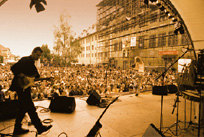
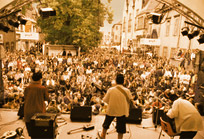
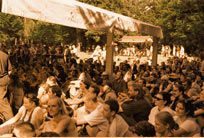

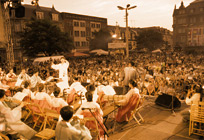
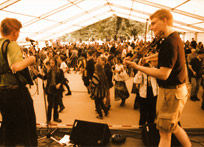
![]()